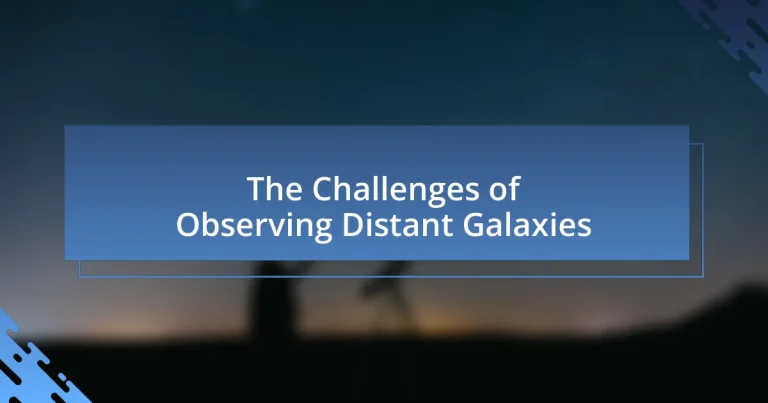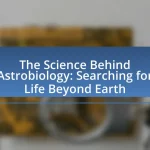The article focuses on the challenges of observing distant galaxies, highlighting key obstacles such as light pollution, cosmic dust interference, and the limitations of current telescopic technology. It explains how distance affects galaxy brightness and resolution, introduces the concept of redshift, and discusses the impact of atmospheric conditions on observations. The article also outlines technological advancements needed for improved observations, including enhanced telescope sensitivity and adaptive optics, while emphasizing the role of space telescopes and collaborative international efforts in overcoming these challenges. Additionally, it explores future prospects and emerging technologies that promise to enhance our understanding of distant galaxies.
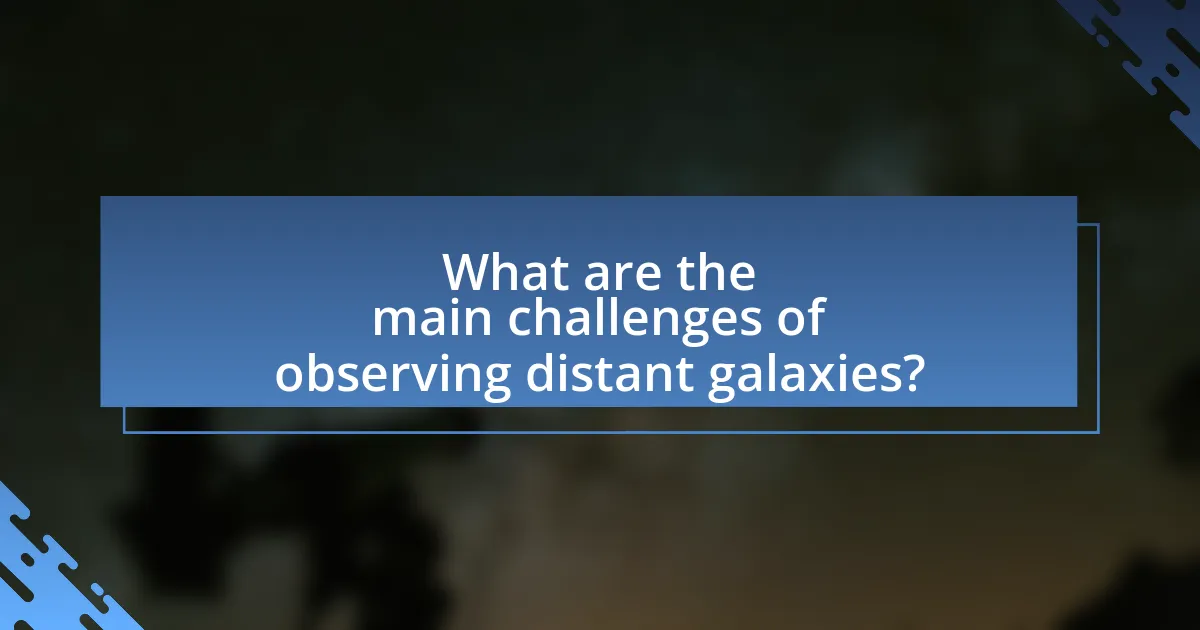
What are the main challenges of observing distant galaxies?
The main challenges of observing distant galaxies include light pollution, cosmic dust interference, and the limitations of current telescopic technology. Light pollution from Earth-based sources can obscure faint celestial objects, making it difficult to capture clear images of distant galaxies. Cosmic dust in the interstellar medium can absorb and scatter light, further complicating observations. Additionally, current telescopes have limitations in their sensitivity and resolution, which restricts the ability to detect and analyze the faint light emitted by these galaxies. For instance, the Hubble Space Telescope, while powerful, can only observe a fraction of the universe’s distant galaxies due to these constraints.
Why is distance a significant factor in galaxy observation?
Distance is a significant factor in galaxy observation because it affects the brightness and resolution of the galaxies being studied. As galaxies are located farther away, their light diminishes due to the inverse square law, making them harder to detect and analyze. For instance, the Hubble Space Telescope can observe galaxies billions of light-years away, but the light from these distant galaxies is often faint and requires long exposure times to capture sufficient detail. Additionally, distance introduces challenges such as redshift, where the expansion of the universe stretches the light waves, shifting them toward the red end of the spectrum, complicating the analysis of their composition and movement.
How does the vastness of space affect light travel from distant galaxies?
The vastness of space causes light from distant galaxies to take longer to reach Earth, resulting in observable delays and redshift effects. As light travels through the expanding universe, it stretches, leading to a phenomenon known as redshift, which indicates that the galaxy is moving away from us. For instance, light from the Andromeda Galaxy, which is about 2.537 million light-years away, takes that long to reach us, meaning we see it as it was over two million years ago. This delay in light travel affects our understanding of the universe’s structure and evolution, as we are observing galaxies at various stages of their development.
What role does redshift play in understanding distant galaxies?
Redshift is crucial for understanding distant galaxies as it indicates how fast they are moving away from Earth, providing insights into the universe’s expansion. When light from these galaxies shifts to longer wavelengths, known as redshift, it allows astronomers to measure their velocity and distance. For instance, Edwin Hubble’s observations in the 1920s established a correlation between redshift and distance, leading to the formulation of Hubble’s Law, which quantifies the rate of expansion of the universe. This relationship helps scientists infer the age and size of the universe, as well as the distribution of galaxies across cosmic time.
What technological limitations hinder the observation of distant galaxies?
Technological limitations that hinder the observation of distant galaxies include insufficient resolution, limited sensitivity, and atmospheric interference. Insufficient resolution arises from the inability of current telescopes to distinguish fine details in distant celestial objects due to their vast distances. Limited sensitivity affects the detection of faint light from these galaxies, as existing instruments may not capture the weak signals emitted over billions of light-years. Atmospheric interference, caused by Earth’s atmosphere, distorts and absorbs light, further complicating observations. These factors collectively restrict astronomers’ ability to gather accurate data on distant galaxies, impacting our understanding of the universe.
How do current telescopes limit our ability to observe distant galaxies?
Current telescopes limit our ability to observe distant galaxies primarily due to their sensitivity to light and resolution capabilities. The vast distances involved mean that light from these galaxies is extremely faint, making it challenging for telescopes to detect and resolve them clearly. For instance, the Hubble Space Telescope, while powerful, can only observe galaxies up to a certain redshift, beyond which the light becomes too weak and redshifted to be captured effectively. Additionally, atmospheric interference and light pollution further degrade the quality of observations, limiting the clarity and detail of distant galaxies. These factors collectively hinder our ability to fully explore and understand the universe’s farthest reaches.
What advancements in technology are needed for better observations?
Advancements in technology needed for better observations of distant galaxies include enhanced telescope sensitivity, improved imaging techniques, and advanced data processing algorithms. Enhanced telescope sensitivity, such as that provided by larger apertures and adaptive optics, allows for the detection of fainter light from distant objects. Improved imaging techniques, like interferometry, enable the combination of signals from multiple telescopes to achieve higher resolution images. Advanced data processing algorithms, including machine learning methods, facilitate the analysis of vast amounts of observational data, allowing astronomers to identify and interpret complex patterns in the light from distant galaxies. These technological improvements are essential for overcoming the challenges posed by distance and light pollution in astronomical observations.
How do atmospheric conditions impact the observation of distant galaxies?
Atmospheric conditions significantly impact the observation of distant galaxies by introducing turbulence, light pollution, and absorption of light. Turbulence in the Earth’s atmosphere causes the light from distant galaxies to distort, leading to blurring and twinkling effects that hinder clear imaging. Light pollution from urban areas increases background brightness, making it difficult to detect faint galaxies. Additionally, atmospheric gases absorb certain wavelengths of light, particularly in the ultraviolet and infrared ranges, which can obscure critical information about the galaxies being observed. These factors collectively reduce the quality and accuracy of astronomical observations, necessitating the use of space-based telescopes to bypass atmospheric interference.
What specific atmospheric phenomena interfere with astronomical observations?
Specific atmospheric phenomena that interfere with astronomical observations include clouds, atmospheric turbulence, light pollution, and humidity. Clouds obstruct visibility by blocking light from celestial objects, while atmospheric turbulence causes distortion in the light path, leading to blurring of images. Light pollution from urban areas overwhelms faint astronomical signals, making it difficult to observe distant galaxies. High humidity levels can also scatter light and reduce the clarity of observations. These factors collectively hinder the ability to obtain clear and accurate astronomical data.
How can observatories mitigate the effects of atmospheric disturbances?
Observatories can mitigate the effects of atmospheric disturbances by employing adaptive optics systems that adjust the telescope’s focus in real-time to compensate for atmospheric turbulence. These systems utilize wavefront sensors to measure distortions in incoming light and employ deformable mirrors to correct these distortions, significantly improving image clarity. Research has shown that adaptive optics can enhance the resolution of ground-based telescopes, allowing for observations comparable to those made from space-based observatories. For instance, the Keck Observatory has successfully implemented adaptive optics, resulting in sharper images of distant galaxies and celestial objects.
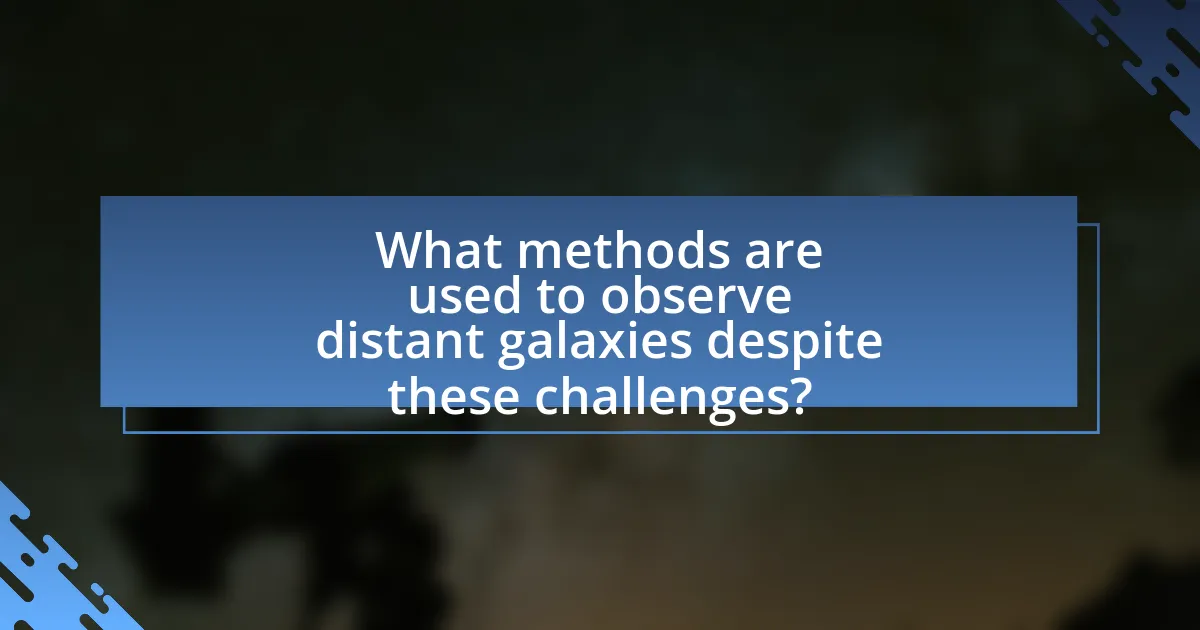
What methods are used to observe distant galaxies despite these challenges?
Astronomers use several methods to observe distant galaxies, including redshift measurements, gravitational lensing, and advanced telescopes equipped with adaptive optics. Redshift measurements allow scientists to determine the distance and velocity of galaxies by analyzing the light spectrum, which shifts toward the red end as galaxies move away. Gravitational lensing occurs when massive objects, like galaxy clusters, bend light from more distant galaxies, making them visible. Advanced telescopes, such as the Hubble Space Telescope and the upcoming James Webb Space Telescope, utilize adaptive optics to correct for atmospheric distortion, enabling clearer images of distant celestial objects. These methods collectively enhance our ability to study galaxies billions of light-years away, overcoming challenges like light attenuation and cosmic expansion.
How do astronomers utilize different wavelengths to study distant galaxies?
Astronomers utilize different wavelengths to study distant galaxies by analyzing the electromagnetic spectrum, which includes radio, infrared, visible, ultraviolet, X-ray, and gamma-ray wavelengths. Each wavelength provides unique information about the physical properties, composition, and dynamics of galaxies. For instance, radio waves can reveal cold gas and star formation regions, while infrared observations can penetrate dust clouds to uncover star formation activity. Visible light allows for the study of stellar populations, and ultraviolet light helps in understanding the hot, young stars. X-ray and gamma-ray observations are crucial for identifying high-energy processes, such as black hole activity and supernova remnants. This multi-wavelength approach enables a comprehensive understanding of galaxy formation and evolution, as evidenced by missions like the Hubble Space Telescope and the Chandra X-ray Observatory, which have provided critical data across these wavelengths.
What advantages do radio waves offer in observing distant galaxies?
Radio waves provide significant advantages in observing distant galaxies due to their ability to penetrate cosmic dust and gas, which often obscures optical observations. This characteristic allows astronomers to gather data on celestial objects that would otherwise be hidden from view. For instance, radio waves can reveal the structure and dynamics of galaxies, including star formation rates and the presence of supermassive black holes, which are critical for understanding galaxy evolution. Additionally, radio telescopes can operate continuously, regardless of weather conditions or time of day, enhancing the consistency and reliability of observations.
How does infrared observation help in overcoming distance challenges?
Infrared observation helps overcome distance challenges by allowing astronomers to detect and analyze light emitted by distant galaxies that is otherwise obscured by cosmic dust. This capability is crucial because visible light can be absorbed or scattered by interstellar material, making it difficult to observe certain celestial objects. For instance, the Hubble Space Telescope primarily captures visible light, while infrared telescopes like the James Webb Space Telescope can penetrate dust clouds, revealing hidden structures and star formation processes in galaxies billions of light-years away. This ability to observe in the infrared spectrum significantly enhances our understanding of the universe’s evolution and the formation of galaxies.
What role do space telescopes play in observing distant galaxies?
Space telescopes play a crucial role in observing distant galaxies by providing unobstructed views of the universe beyond Earth’s atmosphere. This capability allows them to capture high-resolution images and gather data across various wavelengths, including infrared and ultraviolet, which are often absorbed by atmospheric gases. For instance, the Hubble Space Telescope has enabled astronomers to identify and study galaxies billions of light-years away, revealing insights into their formation and evolution. The ability to observe distant galaxies without atmospheric interference significantly enhances our understanding of cosmic phenomena and the structure of the universe.
How do space-based observatories differ from ground-based ones?
Space-based observatories differ from ground-based ones primarily in their ability to avoid atmospheric interference. Space-based observatories, such as the Hubble Space Telescope, operate above Earth’s atmosphere, allowing them to capture clearer images and detect a broader range of wavelengths, including ultraviolet and infrared light, which are absorbed by the atmosphere. In contrast, ground-based observatories face challenges such as atmospheric turbulence, light pollution, and weather conditions, which can significantly degrade the quality of observations. For example, the Hubble Space Telescope has provided high-resolution images of distant galaxies that ground-based telescopes cannot match due to these atmospheric limitations.
What are some notable space telescopes used for galaxy observation?
Notable space telescopes used for galaxy observation include the Hubble Space Telescope, the Chandra X-ray Observatory, and the James Webb Space Telescope. The Hubble Space Telescope, launched in 1990, has provided deep-field images revealing thousands of galaxies, significantly advancing our understanding of galaxy formation and evolution. The Chandra X-ray Observatory, operational since 1999, specializes in observing high-energy phenomena, allowing astronomers to study the hot gas in galaxy clusters and the behavior of supermassive black holes. The James Webb Space Telescope, launched in December 2021, offers unprecedented infrared capabilities, enabling the observation of the earliest galaxies formed after the Big Bang, thus providing insights into the universe’s history.
How do collaborative international efforts enhance galaxy observation?
Collaborative international efforts enhance galaxy observation by pooling resources, expertise, and technology from multiple countries, leading to more comprehensive and efficient research. For instance, projects like the Event Horizon Telescope, which involved over 200 researchers from various institutions worldwide, successfully captured the first image of a black hole by combining data from multiple radio telescopes across the globe. This collaboration allowed for a higher resolution image than any single telescope could achieve, demonstrating that shared efforts can significantly improve observational capabilities and scientific outcomes in the study of distant galaxies.
What are the benefits of global telescope networks in studying distant galaxies?
Global telescope networks enhance the study of distant galaxies by providing continuous observation capabilities and diverse data collection. These networks allow astronomers to monitor celestial events in real-time, overcoming the limitations of individual telescopes that may be hindered by weather or daylight. For instance, the Global Relay of Observatories Watching Transients Happen (GROWTH) network enables rapid follow-up observations of transient events, such as supernovae, across multiple wavelengths. This collaborative approach increases the amount of data available for analysis, leading to more comprehensive understanding of galaxy formation and evolution. Furthermore, the geographical distribution of telescopes helps mitigate the effects of atmospheric disturbances, resulting in clearer images and more accurate measurements.
How do data-sharing initiatives improve our understanding of distant galaxies?
Data-sharing initiatives enhance our understanding of distant galaxies by facilitating collaborative research and access to diverse datasets. These initiatives allow astronomers to combine observations from various telescopes and instruments, leading to more comprehensive analyses of galaxy formation, evolution, and composition. For instance, the Sloan Digital Sky Survey has provided extensive data that researchers use to study the large-scale structure of the universe, revealing insights into the distribution of galaxies and dark matter. By pooling resources and knowledge, data-sharing initiatives accelerate discoveries and improve the accuracy of models that explain the behavior of distant galaxies.
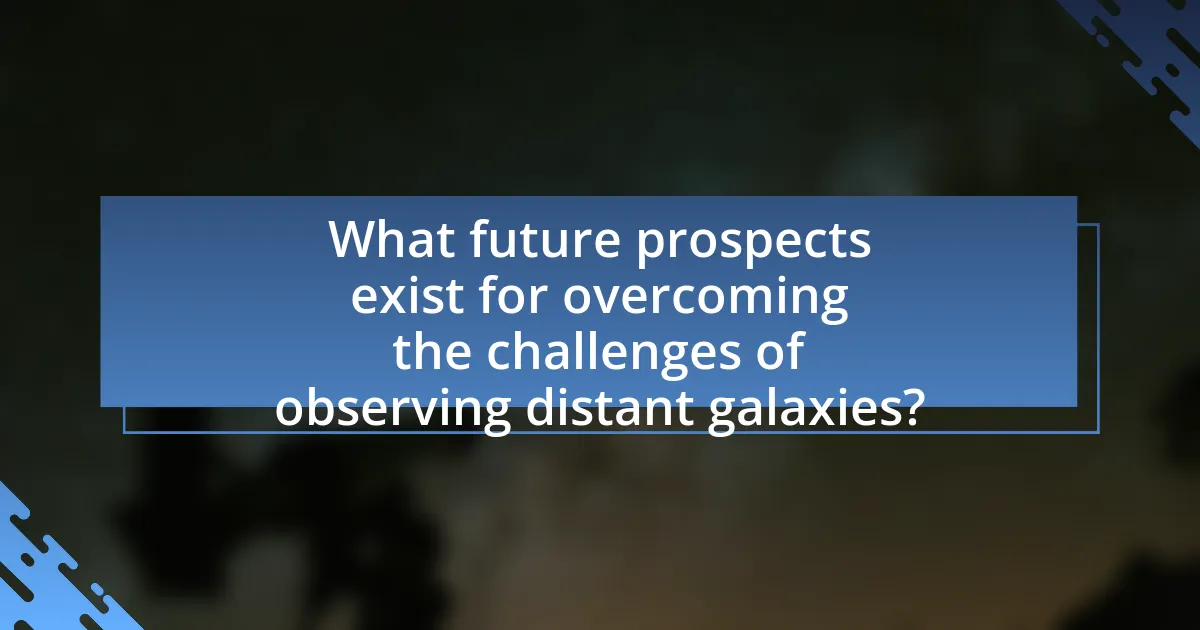
What future prospects exist for overcoming the challenges of observing distant galaxies?
Future prospects for overcoming the challenges of observing distant galaxies include advancements in telescope technology, such as the development of the James Webb Space Telescope, which utilizes infrared capabilities to penetrate cosmic dust and observe early galaxies. Additionally, the implementation of adaptive optics in ground-based telescopes enhances image clarity by compensating for atmospheric distortion. These technologies are supported by ongoing research in astrophysics, which aims to refine observational techniques and improve data analysis methods, thereby increasing our understanding of galaxy formation and evolution.
What emerging technologies show promise for better galaxy observation?
Emerging technologies that show promise for better galaxy observation include advanced telescopes, artificial intelligence, and adaptive optics systems. Advanced telescopes, such as the James Webb Space Telescope, utilize infrared technology to observe distant galaxies with unprecedented clarity, allowing astronomers to study their formation and evolution. Artificial intelligence enhances data analysis by processing vast amounts of astronomical data quickly, identifying patterns and anomalies that human researchers might miss. Adaptive optics systems correct for atmospheric distortion in real-time, significantly improving image quality from ground-based observatories. These technologies collectively enhance our ability to observe and understand distant galaxies, addressing the challenges posed by their vast distances and the limitations of previous observational methods.
How might advancements in adaptive optics improve observations?
Advancements in adaptive optics significantly enhance astronomical observations by correcting distortions caused by Earth’s atmosphere. These technologies utilize real-time adjustments to optical systems, allowing telescopes to achieve sharper images and improved resolution. For instance, the Keck Observatory employs adaptive optics to reduce atmospheric blurring, resulting in images that are up to 10 times clearer than those obtained without such systems. This capability enables astronomers to study distant galaxies with greater detail, facilitating the analysis of their structure, composition, and dynamics.
What potential does artificial intelligence hold for analyzing astronomical data?
Artificial intelligence holds significant potential for analyzing astronomical data by enhancing the speed and accuracy of data processing and interpretation. AI algorithms can efficiently sift through vast datasets generated by telescopes, identifying patterns and anomalies that may be missed by human analysts. For instance, machine learning techniques have been successfully applied to classify galaxies, detect exoplanets, and analyze cosmic microwave background radiation, demonstrating their effectiveness in handling complex astronomical tasks. Research published in the journal “Nature Astronomy” by researchers at the University of California, Berkeley, highlights how AI can improve the identification of distant galaxies by automating the classification process, achieving accuracy rates exceeding 90%. This capability not only accelerates research but also enables astronomers to focus on more intricate analyses and discoveries.
What are the implications of upcoming space missions for galaxy observation?
Upcoming space missions will significantly enhance galaxy observation by providing advanced instruments capable of capturing high-resolution images and data across various wavelengths. For instance, the James Webb Space Telescope, set to launch in December 2021, is designed to observe the universe in infrared, allowing astronomers to study the formation of galaxies and their evolution over time. This capability is crucial because many distant galaxies emit light that is redshifted due to the expansion of the universe, making infrared observation essential for accurate analysis. Additionally, missions like the European Space Agency’s Euclid satellite, scheduled for launch in 2022, aim to map the geometry of the dark universe, which will improve our understanding of galaxy distribution and dark matter’s role in galaxy formation. These missions collectively promise to provide unprecedented insights into the structure and behavior of galaxies, addressing long-standing challenges in observational astronomy.
How will the James Webb Space Telescope contribute to our understanding of distant galaxies?
The James Webb Space Telescope will enhance our understanding of distant galaxies by providing unprecedented infrared observations that can penetrate cosmic dust and reveal the formation and evolution of these galaxies. Its advanced instruments, such as the Near Infrared Camera (NIRCam) and the Mid-Infrared Instrument (MIRI), allow it to detect light from the earliest galaxies formed after the Big Bang, enabling astronomers to study their structure, composition, and star formation rates. This capability is crucial because traditional telescopes struggle to observe these distant objects due to their faintness and the interference of dust. The data collected by the James Webb Space Telescope will thus fill significant gaps in our knowledge about the universe’s history and the processes that shaped it.
What future missions are planned to enhance our observational capabilities?
Future missions planned to enhance our observational capabilities include the James Webb Space Telescope (JWST), the European Space Agency’s Euclid mission, and NASA’s Roman Space Telescope. JWST, launched in December 2021, aims to observe the universe’s first galaxies and study their formation and evolution. Euclid, set to launch in 2023, will map the geometry of the dark universe and investigate dark energy and dark matter. The Roman Space Telescope, scheduled for launch in the mid-2020s, will conduct wide-field surveys to explore the universe’s structure and the distribution of galaxies. These missions are designed to significantly improve our understanding of distant galaxies and the overall cosmos.
What practical tips can astronomers use to improve their observations of distant galaxies?
Astronomers can improve their observations of distant galaxies by utilizing advanced telescopes equipped with adaptive optics, which correct for atmospheric distortion. This technology enhances image clarity and allows for more detailed studies of galaxy structures. Additionally, employing multi-wavelength observations, such as infrared and radio frequencies, enables astronomers to gather data that is less affected by cosmic dust, revealing hidden features of galaxies. Research has shown that combining data from different wavelengths can lead to a more comprehensive understanding of galaxy formation and evolution, as evidenced by studies conducted using the Hubble Space Telescope and the Atacama Large Millimeter/submillimeter Array.
How can careful planning and technique adjustments enhance observation quality?
Careful planning and technique adjustments significantly enhance observation quality by optimizing the use of telescopes and instruments to capture clearer and more detailed images of distant galaxies. For instance, meticulous scheduling of observations during optimal atmospheric conditions reduces the impact of turbulence and light pollution, leading to sharper images. Additionally, employing advanced techniques such as adaptive optics compensates for atmospheric distortion, improving resolution. Research has shown that these adjustments can increase the effective resolution of telescopes by a factor of two to three times, allowing astronomers to detect fainter objects and finer details in galaxy structures.
What resources are available for amateur astronomers interested in distant galaxy observation?
Amateur astronomers interested in distant galaxy observation can access several key resources, including online databases, telescopes, and community forums. Online databases such as the Sloan Digital Sky Survey provide extensive catalogs of galaxies, while telescopes like the Hubble Space Telescope offer images and data for public use. Community forums, such as Cloudy Nights, allow amateur astronomers to share experiences and techniques, enhancing their observational skills. These resources collectively support amateur astronomers in overcoming the challenges associated with observing distant galaxies.
